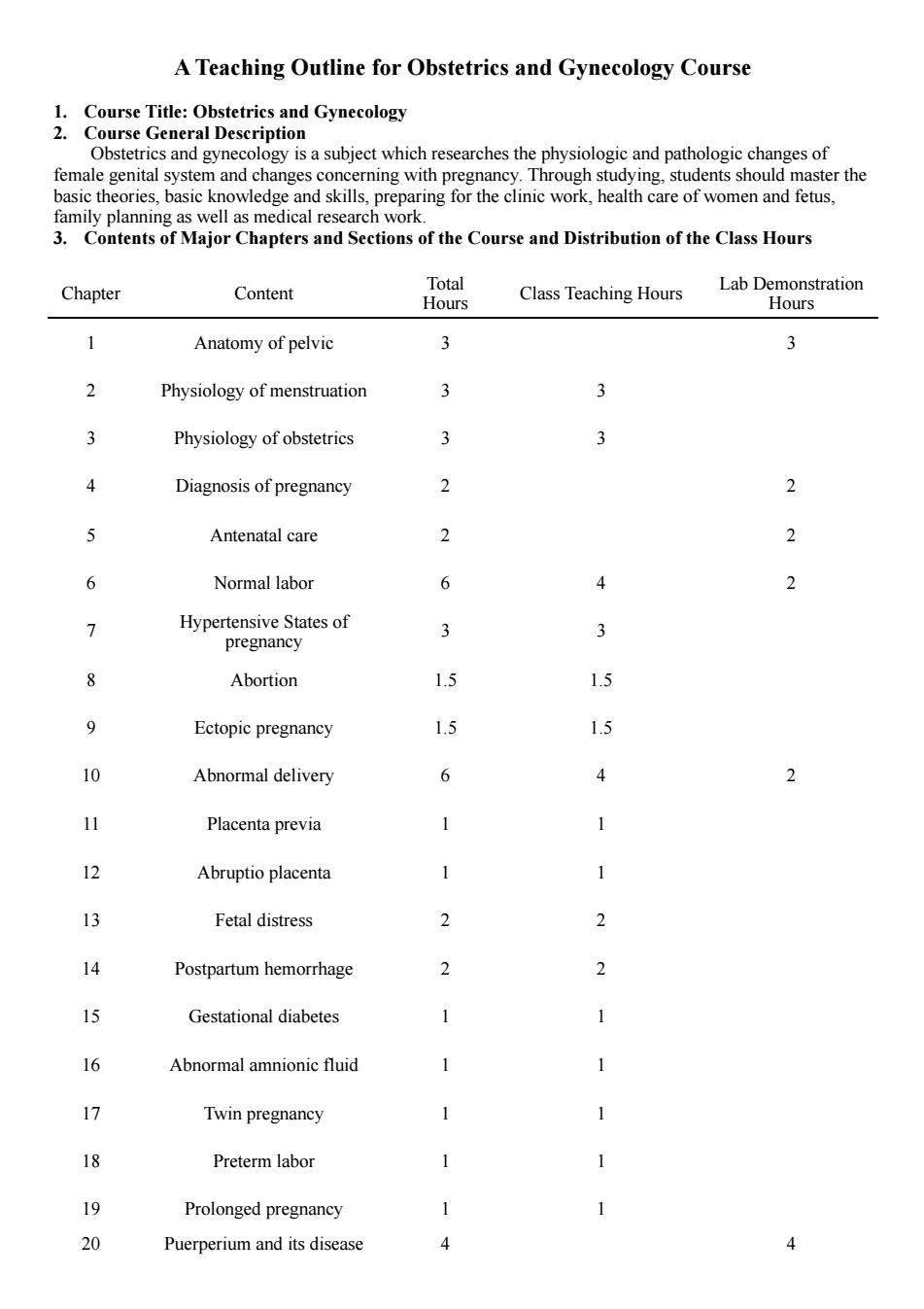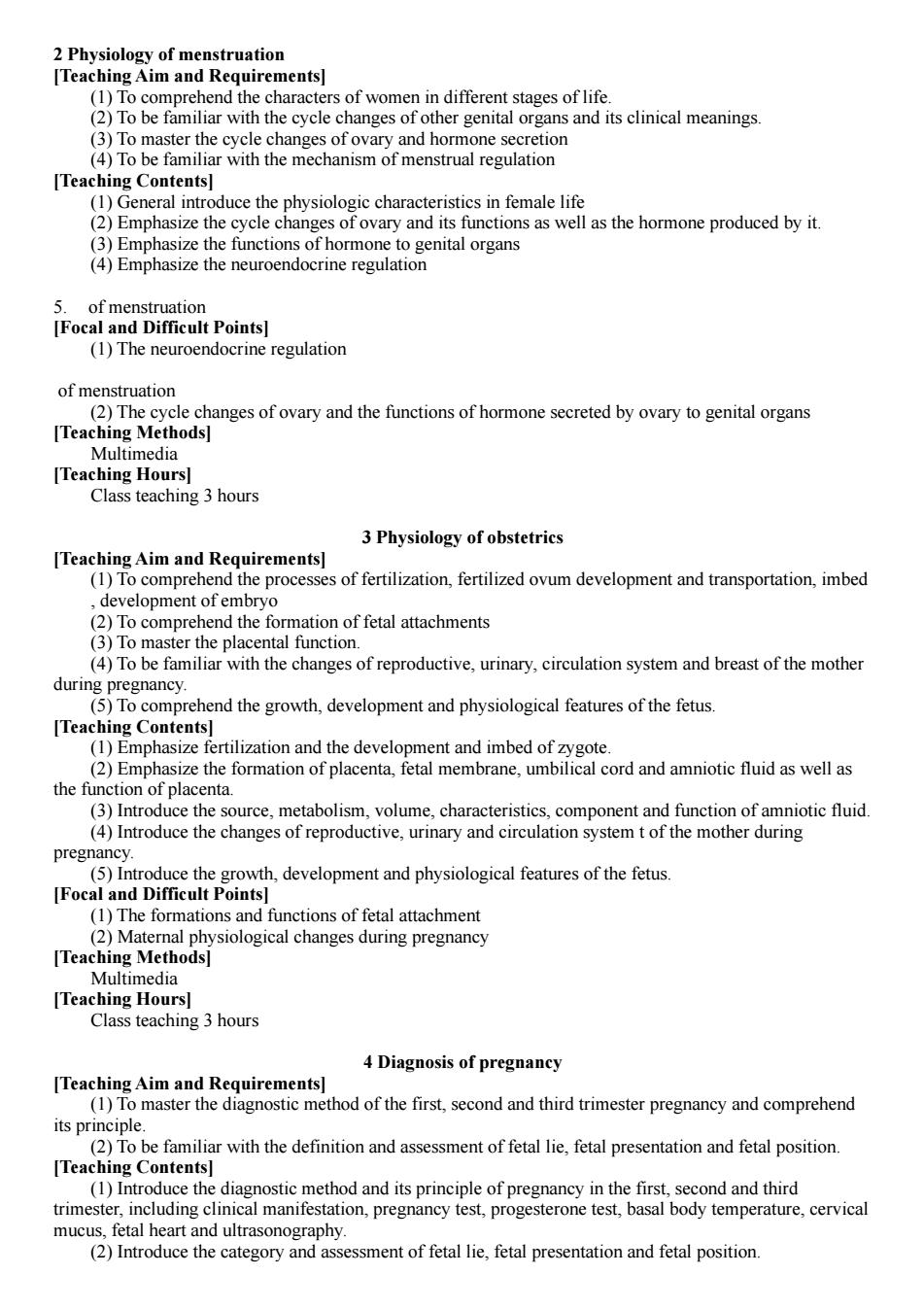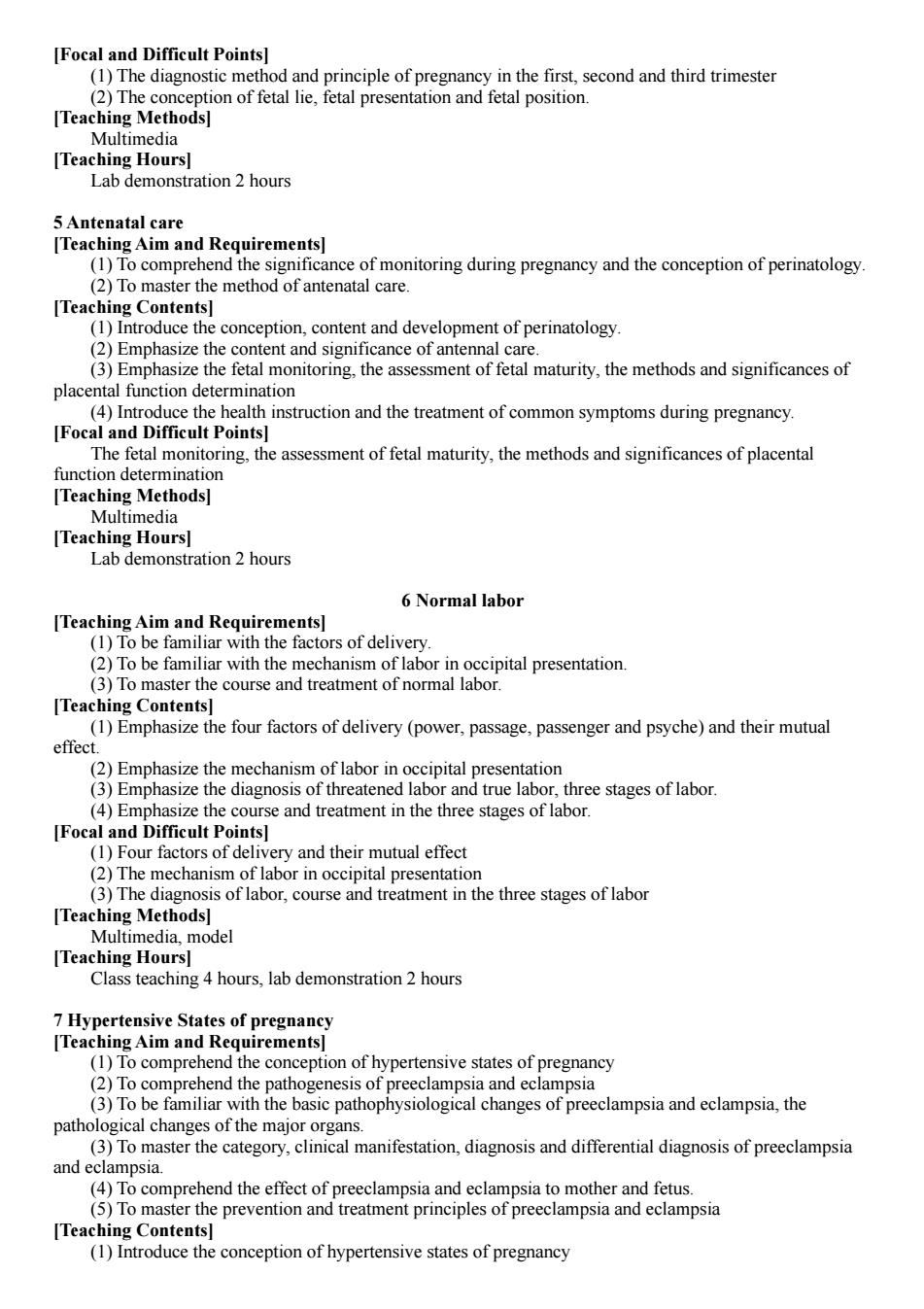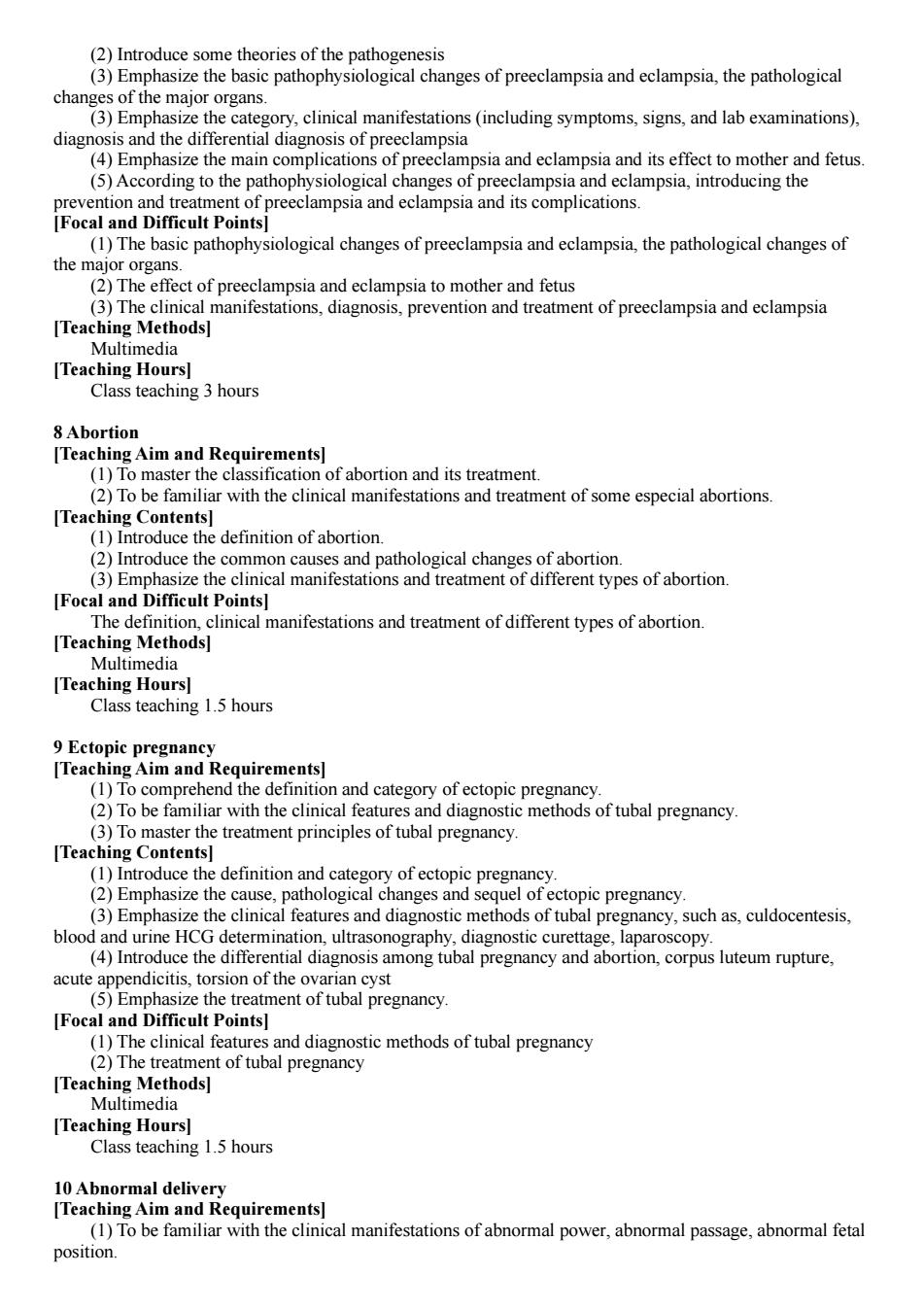
A Teaching Outline for Obstetrics and Gynecology Course zCaecti9iempadGncalhe asic theories,b ic knowledge an Contents of Major Chapters and Sections of the Course and Distribution of the Class Houry Tota Chapter Content Lab Der Hours Class Teaching Hours 1 Anatomy of pelvic 3 3 Physiology of menstruation 3 3 Physiology of obstetrics 3 Diagnosis of pregnancy 2 2 5 Antenatal care 6 Normal labor 6 7 Hypertensive States of 3 3 pregnancy 8 Abortion 1.5 9 Ectopic pregnancy 1.5 15 Abnormal delivery 6 11 Placenta previa 12 Abruptio placenta 1 Fetal distress 2 Postpartum hemorrhage 15 Gestational diabetes 1 1 6 Abnormal amnionic fluid 1 Twin pregnancy 18 Preterm labor 1 19 Prolonged pregnancy 20 Puerperium and its disease 4 4
A Teaching Outline for Obstetrics and Gynecology Course 1. Course Title: Obstetrics and Gynecology 2. Course General Description Obstetrics and gynecology is a subject which researches the physiologic and pathologic changes of female genital system and changes concerning with pregnancy. Through studying, students should master the basic theories, basic knowledge and skills, preparing for the clinic work, health care of women and fetus, family planning as well as medical research work. 3. Contents of Major Chapters and Sections of the Course and Distribution of the Class Hours Chapter Content Total Hours Class Teaching Hours Lab Demonstration Hours 1 Anatomy of pelvic 3 3 2 Physiology of menstruation 3 3 3 Physiology of obstetrics 3 3 4 Diagnosis of pregnancy 2 2 5 Antenatal care 2 2 6 Normal labor 6 4 2 7 Hypertensive States of pregnancy 3 3 8 Abortion 1.5 1.5 9 Ectopic pregnancy 1.5 1.5 10 Abnormal delivery 6 4 2 11 Placenta previa 1 1 12 Abruptio placenta 1 1 13 Fetal distress 2 2 14 Postpartum hemorrhage 2 2 15 Gestational diabetes 1 1 16 Abnormal amnionic fluid 1 1 17 Twin pregnancy 1 1 18 Preterm labor 1 1 19 Prolonged pregnancy 1 1 20 Puerperium and its disease 4 4

21 4 22 Gynecological infections 5 23 Pelvic pain and endometriosis 4 1 24 Uterine neoplasia 5 3 2 25 Cervical neoplasia 5 26 Ovarian neoplasia 6 27 Disorders of menstruation 6 4 2 28 Trophoblastic disease 5 3 2 29 Menopause 2 30 Genital prolapse and urinary disorders 2 31 Infertility 3 3 32 Family planning Total 98 64 34 4. Specific Requirements for Each Chapter and Section 1 Anatomy of pelvic [Teaching Aim and Requirements] (1)To comprehend the distribution of blood vessels,lymphatic vessels and nerves as well as the anatomy of pelvis. (2)To be familiar with the structure and shape characters of female pelvis,anatomy markers of pelvis concerning with delivery. (3)To be familiar with anatomy of internal and external genital organs as well as the relationship y introduce the anatomic nosition and characters of external genital organs (2)Emphasize the formation and shape char acters of female pelvis and th ane of pelvis. organs (4)Generally introduce blood vessels (5)Generally introduce the configuration of pelvic floor rp ceo fmeplvsmmscoe deliv (2)The anatomic characters of genital organs and the relationship between adjacent organs Teaching Methods] Multimedia [Teaching Hours] Lab demonstration 3 hours
21 Gynecological history taking and pelvic examination 4 4 22 Gynecological infections 5 4 1 23 Pelvic pain and endometriosis 4 3 1 24 Uterine neoplasia 5 3 2 25 Cervical neoplasia 5 3 2 26 Ovarian neoplasia 6 4 2 27 Disorders of menstruation 6 4 2 28 Trophoblastic disease 5 3 2 29 Menopause 2 2 30 Genital prolapse and urinary disorders 2 2 31 Infertility 3 3 32 Family planning 5 2 3 Total 98 64 34 4. Specific Requirements for Each Chapter and Section 1 Anatomy of pelvic [Teaching Aim and Requirements] (1) To comprehend the distribution of blood vessels, lymphatic vessels and nerves as well as the anatomy of pelvis. (2) To be familiar with the structure and shape characters of female pelvis, anatomy markers of pelvis concerning with delivery. (3) To be familiar with anatomy of internal and external genital organs as well as the relationship between adjacent organs [Teaching Contents] (1) Generally introduce the anatomic position and characters of external genital organs (2) Emphasize the formation and shape characters of female pelvis and three plane of pelvis. (3) Emphasize the anatomic characters of internal genital organs and the relationship between adjacent organs (4) Generally introduce blood vessels (5) Generally introduce the configuration of pelvic floor [Focal and Difficult Points] (1) The structure and shape characters of female pelvis, anatomy markers of pelvis concerning with delivery. (2) The anatomic characters of internal genital organs and the relationship between adjacent organs [Teaching Methods] Multimedia [Teaching Hours] Lab demonstration 3 hours

2Physiology of menstruation [Teaching Aim and Requirements] h the omen in difrerentsorgans and its clinical meanings. cycle change 10g the nd h (4)To be familiar with the mechans m of menstrual regulation [Teaching Contentsl (1)General introduce the physiologic characteristics in female life (2)Emphasize the cycle changes of ovary and its functions as well as the hormone produced by it. (3)Emphasize the functions of hormone to genital organs (4)Emphasize the neuroendocrine regulation (1)The neu endocrin ne regulation of menstruation (2)The cycle changes of ovary and the functions of hormone secreted by ovary to genital organs [Teaching Methods] 3 Physiology of obstetrics [Teaching Aim and Requirements] (1)To comprehend the processes of fertilization,fertilized ovum development and transportation,imbed development of embryo (2)To comprehend the formation of fetal attachments (3)To master the placental function (4)To be familiar with the changes of reproductive,urinary,circulation system and breast of the mother during pregnaney Teaching C ehend the growth,development and physiological features of the fetus (1Emphasize fertilization and the development and imbed of zygote. (2)Emphasize the formation of placenta,fetal membrane,umbilical cord and amniotic fluid as well as the function of placenta. (3)Introduce the source,metabolism,volume,characteristics,component and function of amniotic fluid. (4)Introduce the changes of reproductive.urinary and circulation system t of the mother during trodu and functions of fetal attachment (2)Mate du ing pregna [Teaching Methods Multimedia [Teaching Hours] Class teaching 3 hours 4 Diagnosis of pregnancy its principle (2)To be familiar with the definition and assessment of fetal lie.fetal presentation and fetal position [Teaching Contents] (1)Introduce the diagnostic method and its principle of pregnancy in the first,second and third trimester,including clinical manifestation,pregnancy test,progesterone test,basal body temperature,cervical mucus,fetal heart and ultrasonography. (2)Introduce the category and asse ssment of fetal lie,fetal presentation and fetal position
2 Physiology of menstruation [Teaching Aim and Requirements] (1) To comprehend the characters of women in different stages of life. (2) To be familiar with the cycle changes of other genital organs and its clinical meanings. (3) To master the cycle changes of ovary and hormone secretion (4) To be familiar with the mechanism of menstrual regulation [Teaching Contents] (1) General introduce the physiologic characteristics in female life (2) Emphasize the cycle changes of ovary and its functions as well as the hormone produced by it. (3) Emphasize the functions of hormone to genital organs (4) Emphasize the neuroendocrine regulation 5. of menstruation [Focal and Difficult Points] (1) The neuroendocrine regulation of menstruation (2) The cycle changes of ovary and the functions of hormone secreted by ovary to genital organs [Teaching Methods] Multimedia [Teaching Hours] Class teaching 3 hours 3 Physiology of obstetrics [Teaching Aim and Requirements] (1) To comprehend the processes of fertilization, fertilized ovum development and transportation, imbed , development of embryo (2) To comprehend the formation of fetal attachments (3) To master the placental function. (4) To be familiar with the changes of reproductive, urinary, circulation system and breast of the mother during pregnancy. (5) To comprehend the growth, development and physiological features of the fetus. [Teaching Contents] (1) Emphasize fertilization and the development and imbed of zygote. (2) Emphasize the formation of placenta, fetal membrane, umbilical cord and amniotic fluid as well as the function of placenta. (3) Introduce the source, metabolism, volume, characteristics, component and function of amniotic fluid. (4) Introduce the changes of reproductive, urinary and circulation system t of the mother during pregnancy. (5) Introduce the growth, development and physiological features of the fetus. [Focal and Difficult Points] (1) The formations and functions of fetal attachment (2) Maternal physiological changes during pregnancy [Teaching Methods] Multimedia [Teaching Hours] Class teaching 3 hours 4 Diagnosis of pregnancy [Teaching Aim and Requirements] (1) To master the diagnostic method of the first, second and third trimester pregnancy and comprehend its principle. (2) To be familiar with the definition and assessment of fetal lie, fetal presentation and fetal position. [Teaching Contents] (1) Introduce the diagnostic method and its principle of pregnancy in the first, second and third trimester, including clinical manifestation, pregnancy test, progesterone test, basal body temperature, cervical mucus, fetal heart and ultrasonography. (2) Introduce the category and assessment of fetal lie, fetal presentation and fetal position

[Focal and Difficult Points] (1)The diagnostic method and principle of pregnancy in the first,second and third trimester Teae2)The gcception of fetal lie,fetal presentation and fetal position. [Teaching Ho Lab den onstration 2 hours 5 Antenatal care [Teaching Aim and Requirements] (1)To comprehend the significance of monitoring during pregnancy and the conception of perinatology (2)To master the method of antenatal care. [Teac hing Contents nte and development of perinatology. the methodsand of placental function determination (4)Introduce the health instruction and the treatment of common symptoms during pregnancy. [Focal and Difficult Points] The fetal monitoring,the assessment of fetal maturity,the methods and significances of placental function determinat Tea ning Me Tea r ration 2 hours 6 Normal labor [Teaching Aim and Requirements] (1)To be familiar with the factors of delivery. (2)To be familiar with the mechanism of labor in occipital presentation. 1o ma e course and treatment of normal labor Emphasize the four factors of delivery (power,passage,passenger and psyche)and their mutual (2)Emphasize the mechanism of labor in occipital presentation (3)Emphasize the diagnosis of threatened labor and true labor,three stages of labor. (4)Emphasize the course and treatment in the three stages of labor. [Focal and Difficult Points] (1)Four factors of delivery and their mutual effect [Teaching Hours] Class teaching 4 hours,lab demonstration 2 hours Hypertensive States of pregnancy [Teaching Aim and Requirements e conception of hypertensive state of pregnancy prehend t the nogenes and ecla of the hophysi anges of preeclampsia and eclampsia.the and eclamnsia (4)To comprehend the effect of preeclampsia and eclampsia to mother and fetus. (5)To master the prevention and treatment principles of preeclampsia and eclampsia [Teaching Contents] (1)Introduce the conception of hypertensive states of pregnancy
[Focal and Difficult Points] (1) The diagnostic method and principle of pregnancy in the first, second and third trimester (2) The conception of fetal lie, fetal presentation and fetal position. [Teaching Methods] Multimedia [Teaching Hours] Lab demonstration 2 hours 5 Antenatal care [Teaching Aim and Requirements] (1) To comprehend the significance of monitoring during pregnancy and the conception of perinatology. (2) To master the method of antenatal care. [Teaching Contents] (1) Introduce the conception, content and development of perinatology. (2) Emphasize the content and significance of antennal care. (3) Emphasize the fetal monitoring, the assessment of fetal maturity, the methods and significances of placental function determination (4) Introduce the health instruction and the treatment of common symptoms during pregnancy. [Focal and Difficult Points] The fetal monitoring, the assessment of fetal maturity, the methods and significances of placental function determination [Teaching Methods] Multimedia [Teaching Hours] Lab demonstration 2 hours 6 Normal labor [Teaching Aim and Requirements] (1) To be familiar with the factors of delivery. (2) To be familiar with the mechanism of labor in occipital presentation. (3) To master the course and treatment of normal labor. [Teaching Contents] (1) Emphasize the four factors of delivery (power, passage, passenger and psyche) and their mutual effect. (2) Emphasize the mechanism of labor in occipital presentation (3) Emphasize the diagnosis of threatened labor and true labor, three stages of labor. (4) Emphasize the course and treatment in the three stages of labor. [Focal and Difficult Points] (1) Four factors of delivery and their mutual effect (2) The mechanism of labor in occipital presentation (3) The diagnosis of labor, course and treatment in the three stages of labor [Teaching Methods] Multimedia, model [Teaching Hours] Class teaching 4 hours, lab demonstration 2 hours 7 Hypertensive States of pregnancy [Teaching Aim and Requirements] (1) To comprehend the conception of hypertensive states of pregnancy (2) To comprehend the pathogenesis of preeclampsia and eclampsia (3) To be familiar with the basic pathophysiological changes of preeclampsia and eclampsia, the pathological changes of the major organs. (3) To master the category, clinical manifestation, diagnosis and differential diagnosis of preeclampsia and eclampsia. (4) To comprehend the effect of preeclampsia and eclampsia to mother and fetus. (5) To master the prevention and treatment principles of preeclampsia and eclampsia [Teaching Contents] (1) Introduce the conception of hypertensive states of pregnancy

(2)Introduce some theories of the pathogenesis (3)Emphasize the basic pathophysiological changes of preeclampsia and eclampsia,the pathological 管 he major organs dia ry.clinical manifestations(including symptoms,signs,and lab examinations) (4)Emphasize the main compl catior and eclampsia and its effect to mother and fetus (5)According to the pathophys siological changes of preeclampsia and eclampsia,introducing the prevention and treatment of preeclampsia and eclampsia and its complications. [Focal and Difficult Points] (1)The basic pathophysiological changes of preeclampsia and eclampsia,the pathological changes of the ect of pre mpsia and eclampsia to mother and fetu manifestations,diagnosis,prevention and treatment of preeclampsia and eclampsia [Teaching Hours] Class teaching 3 hours 8Abortion [Teaching Aim and Requirements] of abortion and its treatment fa h the I manifestations and treatment of some especial abortions ce the definition of abortion (2)Introduce the common causes and pathological changes of abortion (3)Emphasize the clinical manifestations and treatment of different types of abortion. [Focal and Difficult Points] The definition,clinical manifestations and treatment of different types of abortion. [Teaching Methods] Multin edia Tea 9 Ectopic pregnancy [Teaching Aim and Requirements] (1)To comprehend the definition and category of ectopic pregnancy. (2)To be familiar with the clinical features and diagnostic methods of tubal pregnancy. (3)To master the treatment principles of tubal pregnancy. ce the definition and category of ectopic pregnaney (3)Em hasize the clinical featu and dia ti fubiepreg ncy such as culdocentesis blood and urine HCG det diag (4)Introduce the differential diagnosis among tubal pregnancy and abortion,corpus luteum rupture, acute appendicitis,torsion of the ovarian cyst (5)Emphasize the treatment of tubal pregnancy. [Focal and Difficult Points] (1)The clnical features and diagnostic methods of tubal pregnancy ent of tubal pregnancy [Teaching Hou Class teaching 1.5 hours 10 Abnormal delivery [Teaching Aim and Requirements] (1)To be familiar with the clinical manifestations of abnormal power,abnormal passage,abnormal fetal position
(2) Introduce some theories of the pathogenesis (3) Emphasize the basic pathophysiological changes of preeclampsia and eclampsia, the pathological changes of the major organs. (3) Emphasize the category, clinical manifestations (including symptoms, signs, and lab examinations), diagnosis and the differential diagnosis of preeclampsia (4) Emphasize the main complications of preeclampsia and eclampsia and its effect to mother and fetus. (5) According to the pathophysiological changes of preeclampsia and eclampsia, introducing the prevention and treatment of preeclampsia and eclampsia and its complications. [Focal and Difficult Points] (1) The basic pathophysiological changes of preeclampsia and eclampsia, the pathological changes of the major organs. (2) The effect of preeclampsia and eclampsia to mother and fetus (3) The clinical manifestations, diagnosis, prevention and treatment of preeclampsia and eclampsia [Teaching Methods] Multimedia [Teaching Hours] Class teaching 3 hours 8 Abortion [Teaching Aim and Requirements] (1) To master the classification of abortion and its treatment. (2) To be familiar with the clinical manifestations and treatment of some especial abortions. [Teaching Contents] (1) Introduce the definition of abortion. (2) Introduce the common causes and pathological changes of abortion. (3) Emphasize the clinical manifestations and treatment of different types of abortion. [Focal and Difficult Points] The definition, clinical manifestations and treatment of different types of abortion. [Teaching Methods] Multimedia [Teaching Hours] Class teaching 1.5 hours 9 Ectopic pregnancy [Teaching Aim and Requirements] (1) To comprehend the definition and category of ectopic pregnancy. (2) To be familiar with the clinical features and diagnostic methods of tubal pregnancy. (3) To master the treatment principles of tubal pregnancy. [Teaching Contents] (1) Introduce the definition and category of ectopic pregnancy. (2) Emphasize the cause, pathological changes and sequel of ectopic pregnancy. (3) Emphasize the clinical features and diagnostic methods of tubal pregnancy, such as, culdocentesis, blood and urine HCG determination, ultrasonography, diagnostic curettage, laparoscopy. (4) Introduce the differential diagnosis among tubal pregnancy and abortion, corpus luteum rupture, acute appendicitis, torsion of the ovarian cyst (5) Emphasize the treatment of tubal pregnancy. [Focal and Difficult Points] (1) The clinical features and diagnostic methods of tubal pregnancy (2) The treatment of tubal pregnancy [Teaching Methods] Multimedia [Teaching Hours] Class teaching 1.5 hours 10 Abnormal delivery [Teaching Aim and Requirements] (1) To be familiar with the clinical manifestations of abnormal power, abnormal passage, abnormal fetal position